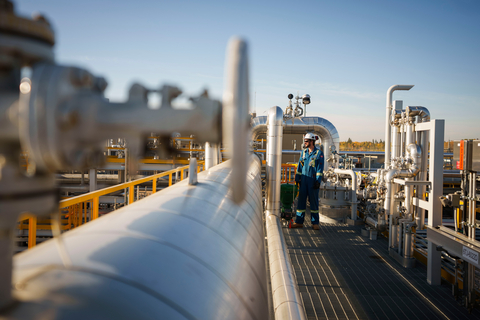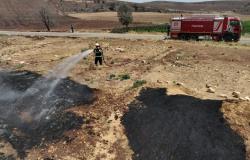
Increased production to 15,000 barrels per day with low GHG emissions Reduction in emissions intensity expected by 40% compared to existing technologies Supports the goal of reducing the emissions intensity of its oil sands assets exploited by 30% by 2030
Imperial (TSE: IMO, NYSE American: IMO) today announced that its Grand Rapids oil sands project has begun production at Cold Lake, marking the first commercial deployment of recovery technology that uses less steam to reduce emissions intensity.
This press release contains multimedia elements. See the full press release here: https://www.businesswire.com/news/home/20240522128423/en/

(Photo: Business Wire)
The project, located at Imperial’s Cold Lake operations site, is expected to reduce the intensity of greenhouse gas emissions by 40% compared to processes currently used. This technology, called solvent-enhanced steam-stimulated gravity separation (SGSIV-AS), uses lighter oil mixed with steam to recover oil from underground deposits. Imperial developed and piloted this technology, which is the first to be deployed in the industry.
“Grand Rapids represents a key milestone in Imperial’s plans to continue to reduce emissions and deliver value to shareholders through high-value opportunities that continue to increase production and reduce costs,” said Brad Corson, Chairman, President and CEO.
“At Cold Lake, we are working to transition approximately 40% of production to lower-emission technologies by 2030. I want to congratulate the teams who brought this project to fruition with over a year of work. ahead of schedule.
Production will continue to increase over the coming months, reaching 15,000 gross barrels per day later this year.
Imperial plans reductions in greenhouse gas emissions intensity over the next decade to support Canada’s net-zero targets. By the end of 2030, Imperial plans to reduce the intensity of Scope 1 and Scope 2 greenhouse gas emissions from its operating oil sands facilities by 30%, compared to 2016 levels. The company plans to achieve this by implementing next-generation technologies at its Cold Lake operations that generate fewer greenhouse gas emissions, improving efficiency at its facilities and using capture and storage. of carbon.
Forward-looking statements: Statements contained in this report that relate to future situations or events, including forecasts, objectives, expectations, estimates and business plans are forward-looking statements. Forward-looking statements include references to Imperial’s 2030 greenhouse gas emissions intensity target for its oil sands operations; the consequences and timing of Phase 1 of the Grand Rapids to Cold Lake Project, including production increases, expected production and reductions in greenhouse gas emissions intensity; and the company’s plans to transition Cold Lake production to lower emissions technologies, improve efficiency and utilize carbon capture and storage, as well as continue to reduce emissions and seek opportunities to increase production and reduce costs, and are based on the company’s current forecasts, estimates, projections and assumptions made at the time of the statement.
Actual financial and operating results that will be achieved, including expectations and assumptions regarding future energy demand, supply and allocation of sources; on the plans, schedule, costs, technical evaluations and capabilities of the projects, as well as the Company’s ability to effectively execute those plans and operate its assets, including Phase 1 of the Grand Rapids to Cold Lake project ; on the adoption and impact of new facilities and technologies with respect to reductions in greenhouse gas intensity, including the replacement of the energy-intensive steam process at Cold Lake with solvents, Kearl boiler flue gas technology, Strathcona renewable diesel, carbon capture and storage, recovery technologies and efficiency projects, and any changes to the scope, terms or costs of these projects; on gaining the necessary support from policymakers and other stakeholders for various new technologies; on the availability and cost of locally obtained and grown feedstocks and the supply of renewable diesel to British Columbia under its low-carbon fuels legislation; on the amount and timing of emissions reductions, including the impact of low-carbon fuels; on the results of research programs and new technologies, particularly with regard to greenhouse gas emissions, and the ability to deploy new technologies on a commercial scale at a competitive cost and the competitiveness of energy sources alternative and other emissions reduction technologies; on obtaining timely approval from third-party and regulatory agencies, including for new technologies that will help the company achieve its emissions reduction targets; on the performance of third party service providers; on commodity prices, exchange rates and general market conditions; on applicable laws and government policies, including with respect to climate change, greenhouse gas emission reductions and low-carbon fuels, may be materially different depending on a number of factors.
These factors include global, regional and local variations in supply and demand for oil, natural gas and petroleum and petrochemical products and their effects on prices, spread and margin, including actions taken by foreign governments with respect to supply levels and prices and the occurrence of wars; political events or regulatory developments, including changes to legislation or government policies; environmental regulations, including regulations and changes to those regulations that relate to climate change and greenhouse gas emissions; failures, delays or uncertainty in policies and market developments favorable to the adoption of new low-carbon and other technologies promoting emissions reductions; timely receipt of regulatory approvals, particularly with respect to large-scale emissions reduction projects; project management and schedules and their timely completion; unforeseen technical or operational difficulties; the availability and performance of independent service providers; and other factors discussed under Item 1A, Risk Factors, and Item 7, Management’s Discussion and Analysis, of the Company’s most recent Annual Report on Form 10-K.
Forward-looking statements are not guarantees of future performance and involve a number of risks and uncertainties, some of which are similar to those of other oil and gas companies and others that are unique to Imperial. Imperial’s actual results could differ materially from those implied or expressed in the forward-looking statements, and readers are cautioned not to place undue reliance on them. Imperial Oil undertakes no obligation to publicly update any forward-looking statements provided herein, except as required by law.
Forward-looking statements and other statements regarding Imperial’s environmental, social and sustainability initiatives and aspirations are not an indication that such statements are material to investors or should be disclosed in company documents. filed with securities regulators. Additionally, historical, current and forward-looking environmental, social and sustainability statements may be based on standards for measuring progress that are still developing, internal controls and processes that continue to evolve and assumptions that may change in the future, including the development of new rules. Individual projects or opportunities may progress depending on a number of factors, including the availability of policy support, technology enabling cost-effective abatement, the company’s planning process, and alignment with L partners. Imperial and other stakeholders.
Source: Imperial
After more than a century in business, Imperial continues to lead its industry by leveraging technology and innovation to support the responsible development of Canada’s energy resources. As Canada’s largest petroleum refiner, a leading producer of crude oil and petrochemicals, and a leading national fuels distributor, our company is committed to maintaining high standards in all areas of our business.
View the Source version on businesswire.com: https://www.businesswire.com/news/home/20240522128423/en/





